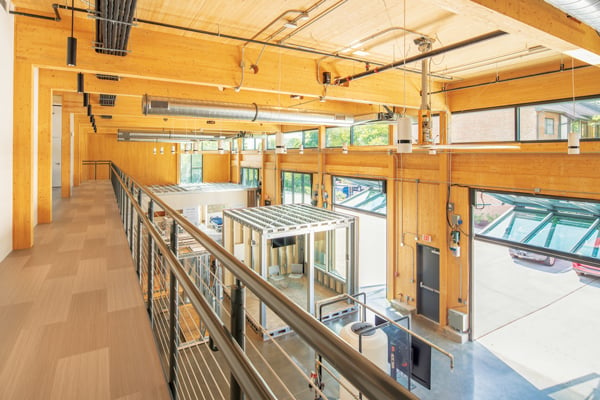Co|Lab: A Hands-On Space for Innovative Construction

HITT Contracting’s new facility aims to be a laboratory of cutting-edge, sustainable building products and technologies.
The construction industry has an innovation problem.
According to recent research from McKinsey, the segment invests less than 1% of its revenue into research and development. As a result, construction labor productivity only increased an average of 1% a year during the past two decades. By comparison, productivity in areas such as manufacturing, retail and agriculture has grown exponentially during the same period.
To help address that gap, HITT Contracting Inc., a national construction company, recently opened Co|Lab, an 8,600-square-foot research facility near its headquarters in Falls Church, Virginia, that will serve as a laboratory for new construction technologies and materials.
“There is no doubt that our industry and commercial real estate are ripe for disruption,” said Kim Roy, the CEO of HITT Contracting. “We want to have education and research be key components of this new facility.”
The initial research projects at Co|Lab include new technology to prevent water intrusion, methods for biocontainment in health care and a material study on a technique that “grows” bricks over 72 hours using microorganisms and calcium carbonate.
“There are some products here that have never been used before,” said Roy.
While the facility will host a revolving selection of cutting-edge construction technologies, the Co|Lab structure itself stands as a showcase of innovative, sustainable building products and practices.
“We focused on energy, carbon and healthy materials in the construction of Co|Lab,” said Katie Rothenberg, HITT’s vice president of sustainability and innovation. She set the project’s sustainability goals and led the design and construction efforts. “We look forward to working with partners to identify opportunities to minimize the environmental impacts of the built environment by testing materials, approaches and technology.”
An Experiment in Sustainable Construction
The Co|Lab site was initially going to be a basketball court for HITT employees, but that changed when the company saw a chance to build a cutting-edge research facility focused on construction sciences.

Co|Lab, which was designed by architectural firm William McDonough + Partners, is the first cross-laminated timber structure in Virginia. The building’s interior includes space to test construction products and technologies. Photo by John Cole, Courtesy of HITT Contracting
“It gave us an opportunity to use the building as an experiment and test things before we engage in research and development with our customers,” said Roy. “We as a company are committed to sustainable construction practices, so building our own building was an opportunity to showcase that commitment.”
Co|Lab is the first cross-laminated timber (CLT) building in Virginia. CLT is a mass timber product in which several boards are stacked in alternating directions and bonded with structural adhesives. Mass timber products such as CLT can be as strong as concrete or steel, but they’re 40% to 60% lighter — and their carbon footprints can be 60% to 75% smaller.
William McDonough + Partners, the architects of Co|Lab, designed prefabricated CLT panels and beams that were transported to the jobsite, moved into place and secured with a just-in-time sequencing method that uses only mechanical fasteners. This reduces the number of tasks that must be performed onsite. The technique also allows for disassembly so that the mass timber elements can be reused or recycled.
While that was an efficient process for raising the building, it required extensive pre-construction planning, said Eric Ross, a director with William McDonough + Partners.
“One of the biggest challenges of working with CLT is making sure you get everything right,” he said. “It is wood, and it’s all manufactured. If you get something wrong in the shop-drawing process, you can’t always fix that in the field, so there was a lot of emphasis put on the modeling of the building. We’re talking intense shop drawing review and field verification.”
It was also demanding for the workers who performed the installation.
“We found a subcontractor that did old-school timber barn raisings, so there was some familiarity there, but it was still a new product for them,” Ross said. “There was a learning curve.”
The building has many other sustainable features in addition to CLT. These include a rooftop photovoltaic solar array that can provide 118 percent of anticipated energy use; an ultra-efficient mechanical, electrical and plumbing (MEP) design with a variant refrigerant flow (VRF) system to cool the space, radiant heat flooring and large fans to circulate air; LED lights throughout; a high-performance concrete facade; and low-flow plumbing fixtures.
Those energy-efficient features helped Co|Lab earn LEED v4 Platinum certification from the U.S. Green Building Council (USGBC). The building is also seeking Petal Certification from the International Living Future Institute (ILFI) by satisfying the requirements for the Materials, Place, and Beauty petals. Finally, because Co|Lab is expected to generate more energy than it consumes, it should receive Zero Energy Certification from ILFI once a year’s worth of performance data has been analyzed.
Challenges and Potential Rewards
While HITT is proud of Co|Lab’s sustainable features, company officials also acknowledge the challenges of building to these strict standards.
“We had so many,” said Roy. “Jurisdictionally, Fairfax County had some questions about the project in the early stages, but I’d say the biggest was anytime you do the first of something, it can take twice as long. With new rating systems, new approaches and the infusion of technology, it just takes a little bit longer the first time.”
According to Rothenberg, Co|Lab cost roughly $1,000 per square foot to build given the first-of-its-kind nature of the facility. Additionally, the small size left no opportunities to leverage economies of scale for labor or materials.
“We knew we were making an investment,” she said. “Our building had to show our commitment to innovation and new ideas, so budget was not the primary driver.”
As part of meeting the Petal Certification requirements, HITT pushed for material ingredient transparency to ensure that building products used in Co|Lab did not include items on ILFI’s Red List. According to ILFI, these are chemicals that pollute the environment, accumulate in the food chain or harm people.
“The Red List was probably the most interesting from a training perspective,” said Drew Mucci, HITT’s co-president. “It was important to get our trade partners and subcontractors to understand that where you would normally use sweeping compound or WD-40, you can’t use that on a project like this. It opens people’s eyes to situations that occur every day that are impacting worker health and the environment, and that forces you to figure out a different way. Once you figure it out, you can employ those solutions in bits and pieces.”
Rothenberg said that while the process of building Co|Lab was often demanding, she thinks the efforts will pay off down the road.
“Working through these challenges will prove incredibly valuable in future mass timber projects,” she said. “And while the building itself is impressive, the real story will lie in the research and testing work that is done inside and outside Co|Lab in the months and years to come.”
Mucci also emphasized the learn-as-you-go aspects of the Co|Lab project.
“What’s really going to be cool is what’s going to happen in the future,” he said. “Part of our goal with Co|Lab was to go all in and commit to using cutting-edge strategies to then be validated through green building certifications. This experience helps us to understand the intricacies of our changing landscape, which can be used to inform our projects and clients into the future.”
Trey Barrineau is the managing editor of Development magazine.




